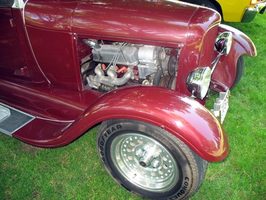A timing chain cover protects the timing chain connecting an engine’s crankshaft to its camshaft. For small-block Chevrolet engines, it is located at the base of the radiator fan shaft. It is important to note that you will have to know how to replace a timing chain cover if you are going to rebuild an engine or exchange camshafts. This fairly simple looking project can become challenging without following the proper steps.
Things You’ll Need
- Fan shaft seal
- Hammer
- Gasket glue
- Gaskets (oil pan, timing chain cover)
- Front engine seal
- Wrench
-
Insert a crankshaft seal into the opening of the timing chain cover and tap it into place. Apply a thin layer of gasket glue to the machined engine seat for the timing chain cover on the front face of the engine. Place a timing chain cover gasket onto the gasket glue and align the holes of the gasket with the bolt holes of the engine. Apply gasket glue on top of the gasket then place the timing chain cover onto the gasket.
-
Push the end of the radiator fan shaft through the hole in the timing chain cover and slide the timing chain cover over the timing chain connecting the camshaft gear to the crankshaft gear at the front of the engine. Make sure to align the bolt holes of the cover with the bolt holes of the engine. Move quickly to set the timing chain cover in place and begin inserting bolts at far points, at the top right, the top left and the bottom center, to keep the cover in place.
-
Insert and tighten all timing chain cover bolts. Insert a front main seal into the lip of the timing chain cover where it will meet the oil pan. Use gasket glue to secure an oil pan gasket in place. Place the oil pan onto its gasket. Make sure there is a good seal where the timing chain cover and oil pan meet.
-
Tighten all the bolts of the oil pan and the timing chain cover. Inspect the seams of both engine covers and continue to assemble the engine or finish the repair by filling the engine with oil to test the seals.
Tips & Warnings
- Silicon can be used to help fill in the gaps around an old oil pan and timing chain cover. Remember to move quickly when working with gasket glues and silicone fillers. The trick is to set them before they have enough time to dry at the surface. Otherwise, this “skin” will prevent the liquid silicon or glue from adhering properly to both surfaces securely.
- Properly seated front seals can last a lifetime, but improperly installed gaskets and seals will leak in no time. Pushing a timing chain cover into an oil pan can warp one or both parts. Running an engine without enough oil will create heat that damages internal parts until a mechanical failure occurs.
